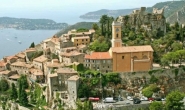DESCRIPTION
 Historic Centre
Historic CentreCalled the «
Ville d’Art et d’Histoire», the town of art and history - Grasse has a great cultural heritage. As the
town of perfume, it has one of the finest collections of ancient objects connected with the history of perfume. Similarly, the factories, distilleries, soap factories and museums should all be visited. Not to mention the “nose workshops,” run by professionals who create new fragrances, seated at their perfume “organs” (a sort of mini-laboratory)..
Located in the hills inland from Cannes, the commune of Grasse includes a large forest estate of which almost a quarter is listed as a natural reserve. As for the undulating, winding roads, these are the delight of experienced cyclists. The town also has the advantage of being close to “La Grande Bleue” – the ocean – and big coastal towns, such as
Cannes or
Antibes…
HISTORY
 A Perspective of Grasse
A Perspective of GrasseThe town long managed to retain its independence. At the start of the Twelfth Century, Grasse became a free town and no longer was part of Provence. The town was then able to develop commercially, focusing on the leather trade amongst others. Grasse established its own trade contacts principally with Pisa and Genoa, which also were autonomous towns. However, at the beginning of the Thirteenth Century, the Count of Provence became concerned about the growing influence of the town and laid siege to it. In 1220, after a fierce battle, the County of Provence was able to boast Grasse as part of its territory.
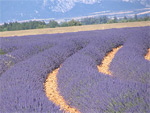 Lavender Fields
Lavender FieldsThe town did however acquire a good many privileges: free trade, free cultivation and livestock farming, reduction and exemption from taxes... It enjoyed privileges at least until the reign of Louis the XIV. The town’s main income derived from arts and crafts and tannery. It was precisely for this reason that the tale of the capital of perfume began. Grasse leather was renowned. However, the odour of hide often left a lot to be desired. So, Galimard had the idea of creating a pair of perfumed leather gloves which he then gave to Catherine de Medici. The trend had been set ! Thus enraptured, the nobility scrapped over them !
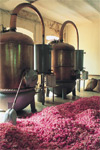 Perfume Stills
Perfume Stills
and PetalsThe perfume industry grew rapidly. The characteristic, rare fragrances of Provence, such as lavender, rose, jasmine and mimosa and others, led to its growing success. After about a century, the tannery trade gradually began to die out. Competition, particularly from Nice, started to make its presence felt and the weight of taxation forced Grasse eventually to abandon the leather industry to the benefit of the perfume business. Later, to meet the demands of the growing scent industry, perfumers took up the production of artificial fragrances. Today, perfume represents the principal industrial hub of the town of Grasse. As for its significance on a national level, the town provides half of all French production of scent and fragrances. Even if competition is tough, Grasse retains its status as the World Capital of Perfume because it represents almost 10% of world production. Grasse’s reputation is already established. Even the big brands such as Chanel have their own rose and jasmine plantations right here in Grasse.
ENTERTAINMENT
The town puts on several
shows and events throughout the year, such as the
Fête du jasmin (Jasmine Festival) which takes place on the first weekend of the month of August, etc.
HAUTE CUISINE
The influence of the
town of perfume also extends to the culinary domain. In the Gorges-du-Loup, a
confectionery offers sweets made from flower petals, including the famous rose petal jam. Sugar-iced violet, mint and rose petals also delight gourmets. You can also visit the sweet-making workshop.
LEISURE
 salon dedicated to Fragonard
salon dedicated to FragonardWhen going through the
old town, you can pass by
Place aux Aires. Specially designed areas provide an outstanding view of Cannes Bay in the distance. Other sights to see are the
Cathédrale Notre-Dame-du-Puy (cathedral), the Hôtel de Ville (town hall), which was the former bishop’s palace, and the
Tour Sarrasine (Saracen Tower), a 30-metre watch tower. Other churches can be visited, such as the
Eglise du Plan de Grasse and the
Eglise de Plascassier.
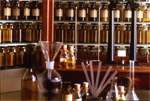 Perfume Laboratory
Perfume LaboratoryThe town also has an
Observatory and a series of museums (
Musée d’Art et d’Histoire de Provence (the Provencal Art and History Museum),
Musée Provençal du Costume et du Bijou (Provencal Museum of Costume and Jewellery),
Musée de la Marine (Museum of the Sea…) including several dedicated to perfumes and their history, such as the
Musée International de la Parfumerie (International Perfume Museum),
the Villa-Musée Jean-Honoré Fragonard (Jean-Honoré Fragonard Villa-Museum) and, naturally, the
Galimard,
Fragonard and
Molinard perfumeries with their museums and workshops... Galimard also arranges visits to their fields of flowers in the village of
Gourdon.
The town also has a
casino.
SPORTS
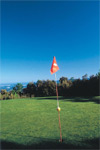 Golf Le Claux Amic
Golf Le Claux AmicWhen it comes to sport, the Grasse area, located between the sea and the mountains offers many possibilities. In addition to skiing and water sports, there is traditional
golf, , which is very sought after in the region. Walkers will be delighted by the hiking and bicycle routes through the hinterland. Horse riding is also widespread with the
Club hippique de Grasse and the
Ecuries d’Epona (stables). For climbers, there are
assault courses in the woods.
PARKS
 Grasse Gardens
Grasse GardensThe town of perfume has many gardens and flower plantations, such as the
Domaine de Manon with fields of jasmine and roses. Other sight-seeing attractions are the
Jardin de la villa-musée Fragonard (Fragonard Villa-Museum Gardens), the
Jardin de la Princesse Pauline (Princess Pauline’s Gardens), the
Jardin de la Villa Fort de France (Gardens of the Villa Fort of France), the
Jardin de la Villa Noailles (Noailles Villa Gardens) and the
Jardin des Plantes (Plant Gardens). Walkers can also go to the
Parc Communal de la Corniche (local park).
LOCATION AND DIRECTIONS
 Fireworks
FireworksIn the hills above
Cannes, the town of Grasse enjoys an outstanding setting. It is near the towns of
Mougins with its old village (which you absolutely must visit),
Mouans Sartoux,
La Roquette-sur-Siagne,
Opio with its oil mills,
Bar-sur-Loup,
Saint-Vallier de Thiey ,
Caussols,
Tourette-sur-loup,
Valbonne… and so on... Not far away, the “perched village” of
Gourdon is home to the flower fields of Grasse for perfume production. Towards the East are the large cities of
Antibes,
Nice,
Monaco,
Menton, etc.
By air :
Nice Côte d’Azur International is the closest airport.
By road :
Take the A8 motorway up to Cannes, then the road known as the “Pénétrante Cannes-Grasse”.
By train :
Grasse railway station was reopened in 2005.
See all Hotels in Grasse.
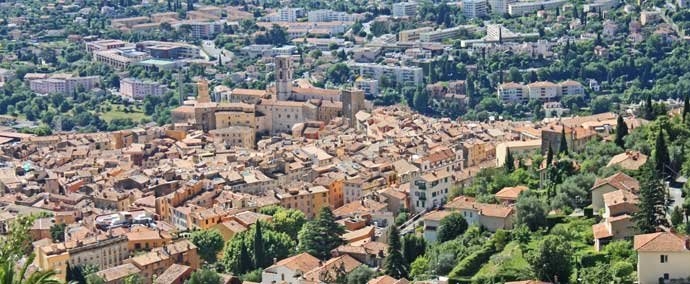
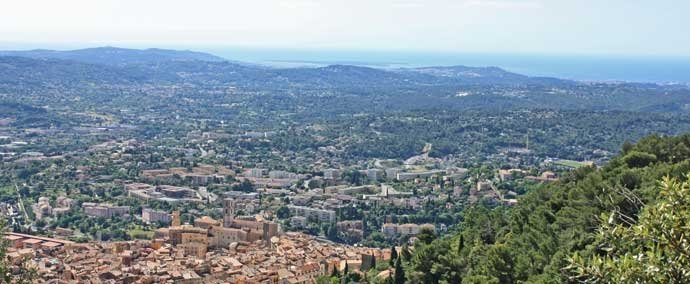











![]()

 Book holidays
Book holidays holiday Rental
holiday Rental Stays in residence
Stays in residence discounts
discounts Book hotel
Book hotel Stays
Stays Excursions
Excursions Sailing and Boating
Sailing and Boating Beaches and seaside
Beaches and seaside Hike
Hike Tourism
Tourism Discoveries
Discoveries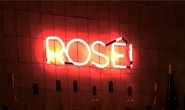
 Cinemas
Cinemas Films
Films Restaurants
Restaurants Recipes
Recipes Activities
Activities Outings
Outings
 car rental
car rental Corsica Ferries
Corsica Ferries Good ideas on the Riviera
Good ideas on the Riviera World within reach of Nice
World within reach of Nice Airline Tickets
Airline Tickets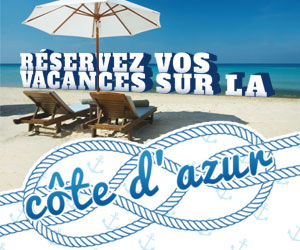
 Real Estate
Real Estate Classified Ads
Classified Ads Facebook
Facebook
 Photo of the Week
Photo of the Week Agenda of the week
Agenda of the week Calendar
Calendar Horoscope
Horoscope Events
Events Our favorites
Our favorites